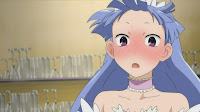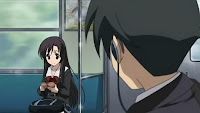 What if the world is not what it seems? And the popsicle you are eating isn't real? How sure are you that the dream that you are dreaming isn't a dream at all? Are you sure that what you see is real? How can you be sure that the person your with is a friend, or an enemy? And... If you are God, and the delusions becomes reality. About what kind of the nodes you get? Is it the sensual world? The despotic society? The destuctive sanctions? Or...
What if the world is not what it seems? And the popsicle you are eating isn't real? How sure are you that the dream that you are dreaming isn't a dream at all? Are you sure that what you see is real? How can you be sure that the person your with is a friend, or an enemy? And... If you are God, and the delusions becomes reality. About what kind of the nodes you get? Is it the sensual world? The despotic society? The destuctive sanctions? Or...Takumi Nishijo has lived the life of a recluse ever since as a child. Afraid of the real world, he spends his days watching anime, collecting vinyl figures, and living a virtual life as Knight Hal in the MMORPG Empire Sweeper Kingdom. He attends school on a minimum basis, obtaining enough credits to pass the mark and living his days as a hikkikomori in his container truck of a room.
 Until one day while chatting with a friend online, he gets a private message from an unknown chatter named Shogun. Clinking on a link attached to a message, he views a pic of a gruesome murder— one that hasn't happen yet. Thinking of it as just some weird joke someone is passing along the web, he forgets about... that is on the following evening, he stumbles on the actual scene himself.
Until one day while chatting with a friend online, he gets a private message from an unknown chatter named Shogun. Clinking on a link attached to a message, he views a pic of a gruesome murder— one that hasn't happen yet. Thinking of it as just some weird joke someone is passing along the web, he forgets about... that is on the following evening, he stumbles on the actual scene himself. Chaos;Head (Kaosu Heddo) is a twelve episode psychological suspense anime set in the flashy district of Shibuya. An Anime adaptation from a Japanese visual novel produced by Nitro+, Red Flagship, and 5pb. — the same visual novel studio that brought you Myself;Yourself. Produced by MadHouse, the same Anime studio that brought you Death Note, Gunslinger Girl, Claymore, Tenjou Tenge, Metropolis, and Trigun fame. Set in the backdrop of the popular Shibuya district; with shops and cafes can be found in Shibuya itself— those names have been altered. Also you may notice that upon watching the Anime, some of the websites that Takumi browses thru are parodies of such popular sites such as Google, Wikipedia, YouTube, and Yahoo.
Chaos;Head (Kaosu Heddo) is a twelve episode psychological suspense anime set in the flashy district of Shibuya. An Anime adaptation from a Japanese visual novel produced by Nitro+, Red Flagship, and 5pb. — the same visual novel studio that brought you Myself;Yourself. Produced by MadHouse, the same Anime studio that brought you Death Note, Gunslinger Girl, Claymore, Tenjou Tenge, Metropolis, and Trigun fame. Set in the backdrop of the popular Shibuya district; with shops and cafes can be found in Shibuya itself— those names have been altered. Also you may notice that upon watching the Anime, some of the websites that Takumi browses thru are parodies of such popular sites such as Google, Wikipedia, YouTube, and Yahoo.As he receives more info on the murder he witnessed, which is part of a string of bizzare murders calle
 d The New Generation Madness. As much as he tries to forget the incident himself, unwanted messages from Shogun and daily feeds from his online friend Grim about the NewGen murders, hounding Takumi daily of the murder. Accused by a female sempai as the actual perpetrator of the NewGen murders and finding out the following day, that the blood-covered girl he saw at the murder scene, is same class as he is, and worst, a long time friend since junior high.
d The New Generation Madness. As much as he tries to forget the incident himself, unwanted messages from Shogun and daily feeds from his online friend Grim about the NewGen murders, hounding Takumi daily of the murder. Accused by a female sempai as the actual perpetrator of the NewGen murders and finding out the following day, that the blood-covered girl he saw at the murder scene, is same class as he is, and worst, a long time friend since junior high. Is he really the perpetrator? Does he have a dual personality? How come he can't recall right away that the girl he's with a friend? Does he have lapses in memory? As he tries to find further the truth behind himself and the murders that have been happening around him, he gets himself entangled with other strange girls. Each having their own reasons for contacting him. The plotline in the first five episodes unravels slowly, but speeds up in the latter parts of the anime, as Takumi steps outside the boundaries of his hikkikomori lifestyle in order to find out the truth. As a bizarre earthquake errupts in the middle of the Shibuya district and other strange events follow afterward. Takumi finds out the name of the organization behind the strange turn of events happening around his home.
Is he really the perpetrator? Does he have a dual personality? How come he can't recall right away that the girl he's with a friend? Does he have lapses in memory? As he tries to find further the truth behind himself and the murders that have been happening around him, he gets himself entangled with other strange girls. Each having their own reasons for contacting him. The plotline in the first five episodes unravels slowly, but speeds up in the latter parts of the anime, as Takumi steps outside the boundaries of his hikkikomori lifestyle in order to find out the truth. As a bizarre earthquake errupts in the middle of the Shibuya district and other strange events follow afterward. Takumi finds out the name of the organization behind the strange turn of events happening around his home.If you think this is your typical harem type romance— your dead wrong abo
 ut it. Not unless, you have a thing for girls carrying swords. The only fan service you get are a by-product of Takumi's attack of schizophrenia, wherein Takumi suddenly views the girls in their lingerie, or acting out 'flagged' scenes found in common date sim or eroge games. And in this case, none of the girls are interested in Takumi for the standard reasons in most date sim games. That is, the near end of the anime may say otherwise.
ut it. Not unless, you have a thing for girls carrying swords. The only fan service you get are a by-product of Takumi's attack of schizophrenia, wherein Takumi suddenly views the girls in their lingerie, or acting out 'flagged' scenes found in common date sim or eroge games. And in this case, none of the girls are interested in Takumi for the standard reasons in most date sim games. That is, the near end of the anime may say otherwise.Chaos;Head is a short anime series with a decent plotline with fair amount of complicated twist to keep the suspense going. Action-wise, those looking for an all-out-sword-battling action, may be disappointed, since most of the action happens at the latter half of the anime. But a good storyline and plot build-up to the end, Chaos;Head is great anime worth watching.






































